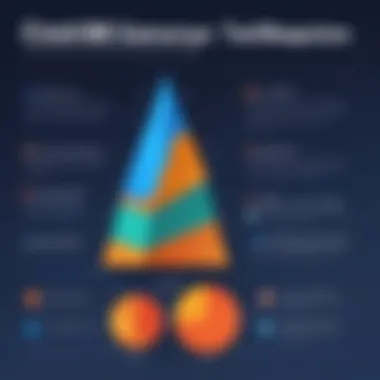Understanding the Financial Aspects of MariaDB


Intro
MariaDB has gained traction as a popular open-source relational database management system. It serves as an alternative to MySQL, particularly after Oracle's acquisition of MySQL. This shift has led many businesses to reconsider their database management strategies. MariaDB’s flexibility and robustness make it an attractive choice. However, with its advantages come various expenses that organizations must navigate.
The costs involved in MariaDB extend beyond simple licensing fees. Installations, hardware requirements, and continuous operations contribute to the overall expenditure. Organizations often overlook hidden costs, which can affect budget planning significantly. A thorough understanding of these factors is crucial for making informed financial decisions in a competitive tech landscape.
Software Category Overview
Purpose and Importance
MariaDB is designed to offer a reliable solution for handling large datasets and high user loads. Businesses utilize it for various applications, including web services, data analytics, and enterprise resource planning. Its open-source nature allows for customization, which is an essential aspect of database management for many organizations. This adaptability is vital for operational efficiency and overall performance.
The importance of accurately assessing the cost implications arises from the need to plan budgets effectively. Firms often find themselves allocating substantial funds to database solutions without understanding where those costs stem from or how they can be optimized.
Current Trends in the Software Category
Several trends are shaping the future of database management systems. Cloud computing is becoming a prominent influence, with many organizations shifting from traditional on-premises setups to cloud-based solutions. MariaDB adapts well to this trend, offering MariaDB Cloud for easier management. Furthermore, the demand for data analytics has surged, pushing businesses to seek databases capable of generating insights from vast amounts of data rapidly.
Cost factors also evolve, as the market presents new database technologies and models. It is essential to evaluate mariaDB not only in isolation but also in comparison with alternatives such as PostgreSQL and Microsoft SQL Server, taking into account the ongoing trend of cloud migrations, subscription licensing, and third-party support.
Data-Driven Analysis
Metrics and Criteria for Evaluation
When evaluating the cost implications of MariaDB, businesses should consider several metrics:
- Licensing Fees: While MariaDB is open-source and thus has no purchase cost, enterprises must consider support and subscription fees for enterprise editions.
- Hardware Requirements: The physical servers supporting database operations can represent a hefty investment.
- Human Resources: Skilled personnel are required for installation, maintenance, and optimization of the database, all of which contribute to ongoing costs.
- Training and Support: Continuous employee training and external consulting support need budgeting too, especially for systems that must run seamlessly.
Comparative Data on Leading Software Solutions
Comparative analysis provides insights into how MariaDB stands against its competitors. For instance:
- Microsoft SQL Server often has higher licensing costs.
- PostgreSQL offers similar capabilities but with distinct features that some businesses may prefer, like advanced data integrity.
- Oracle Database can lead to significant financial commitments due to its licensing model and support costs.
"Understanding the total cost of ownership for a database solution allows organizations to align technology choices with business goals strategically."
Overview of MariaDB Cost Structure
Understanding the cost structure of MariaDB is crucial for organizations that want to effectively manage their database-related expenditures. MariaDB is increasingly favored due to its open-source nature, yet it still comes with a variety of costs that can impact an organization's budget. Knowing these costs helps in making informed decisions about resource allocation.
Several elements contribute to the cost structure. These include direct expenses, which encompass licensing fees and hardware costs, as well as operational costs like maintenance and support. Identifying these costs can prevent unexpected financial burdens in the future. Additionally, it’s essential to consider how these expenses compare to those related to alternative database systems, which can aid in assessing the overall value of choosing MariaDB.
Furthermore, understanding this cost structure aligns with strategic financial planning. Organizations should factor in both initial setup costs and long-term operational costs to grasp their total expenditure. This knowledge enables IT professionals and business leaders to structure budgets and enhance cost management practices effectively.
Preface to MariaDB and Its Pricing Philosophy
MariaDB operates under an open-source licensing model, which fundamentally influences its pricing. The core of MariaDB is free to use, making it attractive for a wide range of businesses. However, while the software itself does not have upfront licensing fees, users must consider other costs associated with deployment and upkeep.
This flexibility allows organizations to customize their usage of the database according to their needs. In many situations, some organizations opt for commercial support and premium features, which may introduce additional expenses. The pricing philosophy behind MariaDB aims to maintain accessibility while ensuring sustainable development and support for users who require more than just the community edition.
Comparison with Other Database Systems
When comparing MariaDB with other database systems, several factors emerge. Traditional database solutions, such as Oracle Database or Microsoft SQL Server, often involve substantial licensing fees, which can deter smaller businesses. In contrast, MariaDB offers a no-cost entry point. This can lead to significant savings in the initial phases of implementation.


However, it is important to look beyond just the direct financial implications. Here are a few points to consider when evaluating MariaDB against its competitors:
- Long-term costs: While MariaDB may have an attractive initial offer, organizations should also assess ongoing costs rather than just upfront expenses.
- Customization and scalability: Some database systems may require expensive upgrades to accommodate growth. In many cases, MariaDB users can scale with less financial strain.
- Community support: The community-driven nature of MariaDB can provide a wealth of resources compared to proprietary systems, offering alternative forms of support that may lessen financial burdens.
By understanding these key comparisons, organizations can make more strategic decisions when considering the total costs associated with implementing MariaDB versus other database systems.
Direct Costs Associated with MariaDB
When considering the financial implications of implementing MariaDB, it is essential to explore the direct costs associated with its use. Direct costs encompass all expenses that a business will incur in the execution of its database management strategy. Understanding these costs helps in planning and budgeting expeditions effectively, which is crucial for maintaining operational efficiency and financial health.
Licensing Fees: Understanding MariaDB’s Open Source Model
MariaDB is an open-source database, which means it does not have traditional licensing fees associated with proprietary software. Users can download and use MariaDB without paying a fee. However, there are some considerations to be mindful of. While the open-source model offers significant cost savings, enterprises may still incur costs related to commercial support or enterprise edition features, should they choose to subscribe for enhanced functionality or assistance. It is advisable to evaluate the specific needs of the organization against the support options available. This proactive assessment can prevent unexpected financial burdens later.
Hardware Costs: Analyzing Server Requirements
Deploying MariaDB requires a careful analysis of server requirements. The configurations of hardware will affect the overall performance of the database. While MariaDB itself is designed to be resource-efficient, the underlying hardware can range from modest setups for small applications to robust systems for enterprise-level demands. Factors to consider include:
- Processor speed and cores: More intensive queries will benefit from higher processing power.
- RAM: Sufficient memory allocation ensures quick data access and query processing.
- Disk type and capacity: SSDs are recommended for better performance; however, the choice may impact initial costs significantly.
Organizations should balance their performance requirements with their budget constraints to make informed hardware investments.
Deployment Costs: Installation and Configuration Expenses
Deployment of MariaDB involves installation and configuration, which can result in direct costs. Though the software itself is free, hiring skilled personnel or contracting external services may be necessary for optimal configuration and deployment. The following aspects could contribute to deployment costs:
- Labor costs: Engaging experienced database administrators can prevent costly mistakes during setup.
- Time investment: The time taken to configure MariaDB for specific needs can delay project timelines, affecting overall costs.
- Integration with existing systems: Ensuring compatibility with other software can also incur additional costs, depending on the complexity of the current infrastructure.
Operational Costs of MariaDB
The operational costs of MariaDB represent a critical aspect of the total cost of ownership when adopting this database management system. These costs extend beyond initial deployment expenses and licensing fees. They encompass ongoing expenditures crucial for maintaining optimal performance and usability within organizational frameworks.
Maintenance and Support Costs
Maintenance and support costs are essential to consider, as they directly impact the operational efficiency of MariaDB. These costs include technical support services, software updates, and performance monitoring tools that keep the system running smoothly.
Costs can vary significantly based on the scale of usage and the complexity of deployment. Organizations may need to consider both in-house support as well as external vendors who specialize in MariaDB solutions. When weighing these options, it's important to evaluate the expertise required, as skilled personnel are crucial for maximizing investment.
Furthermore, organizations often set aside budgets for software updates and upgrades. Regular updates are vital since they tend to include security patches, performance enhancements, and bug fixes. Without proper maintenance, database performance may degrade, leading to higher downtime and decreasing productivity. One useful strategy is to allocate yearly budgets for maintenance, ensuring that funds are available for these unavoidable costs.
Training and Skill Development Expenses
Training and skill development expenses should not be overlooked in the cost analysis of MariaDB. As with any sophisticated technology, having a skilled workforce is imperative. Organizations often face challenges in finding experienced database administrators familiar with MariaDB. Thus, investing in training programs is essential not just to enhance employee skills, but also to maintain high operational standards.
Training costs can include:
- In-house workshops: Custom training sessions led by experienced professionals.
- Online courses: Many platforms offer comprehensive courses tailored to MariaDB.
- Certification programs: Investing in certification for employees can validate their expertise and contribute to smoother project implementation.
Effective training ensures that employees are proficient in utilizing MariaDB's features efficiently, minimizing errors and avoiding costly downtime due to skill gaps. Furthermore, an ongoing investment in skill development fosters a culture of continuous improvement which is beneficial for long-term strategic goals.
"Investing in maintenance and training transforms operational challenges into opportunities for growth."
Hidden Costs of Implementing MariaDB
Incorporating MariaDB into an organization’s infrastructure involves more than just initial setup costs. Understanding the hidden costs can help inform budget decisions and ensure a smoother implementation. These hidden expenses can arise unexpectedly but can significantly impact overall cost management. Evaluating these facets is crucial for achieving a well-rounded financial strategy when adopting MariaDB for database management.


Migration Costs: Transitioning from Other Systems
Migrating to MariaDB from an existing database can entail various expenses that are often overlooked. The initial migration may seem straightforward, but complications frequently arise. Organizations must consider data migration tools, scripting, and data transformation processes. The complexity of the dataset can further complicate this task. Data integrity must be maintained throughout this process; thus, testing becomes vital.
Moreover, teams may require specialist knowledge to handle certain features or functions from the previous database. As a result, hiring external consultants can also add to costs.
To summarize, migration involves:
- Data extraction and cleansing
- Tooling costs for the migration process
- Potential rental of external expertise for a smooth transition
- Testing phases to ensure data accuracy and system functionality
Downtime and Its Financial Impact
Downtime during the migration or setup process can generate significant financial strain. Lost productivity and service interruptions not only affect the bottom line but can also harm reputation. Depending on the industry, the cost of downtime can vary, with some sectors facing steep penalties or losses when services are not available.
During migration, systems may be less stable than usual. If an organization underestimates downtime, the resulting financial implications could be severe. Typically, the following areas are impacted:
- Revenue loss: If customers cannot access services, immediate revenue declines may occur.
- Recovery costs: Fixing errors post-migration can cause delays, necessitating additional spending on manpower or support resources.
- Reputation damage: Extended downtime can lead to loss of trust from clients or stakeholders.
To mitigate these risks, organizations should plan for potential downtimes:
- Create a robust migration strategy that includes backup systems.
- Communicate clearly with stakeholders about expected downtime.
- Prepare financial projections that account for potential service interruptions.
Understanding these hidden costs allows organizations to better navigate the challenges of implementing MariaDB, ensuring they account for all financial implications rather than just the apparent ones.
Cost-Effective Strategies for Using MariaDB
In today's data-driven world, organizations are constantly seeking ways to optimize costs related to their database systems. Implementing effective management strategies for MariaDB can lead to substantial savings while maintaining robust performance and reliability. This section outlines key strategies for utilizing MariaDB in a cost-effective manner, focusing on performance optimization and leveraging community resources.
Optimizing Performance to Reduce Costs
Performance optimization serves as a cornerstone of an effective MariaDB deployment. Enhancing the efficiency of database operations not only benefits organizational productivity but can also directly affect operational costs. Here are several considerations to explore:
- Indexing: Proper implementation of indexes can significantly improve data retrieval speeds. A well-indexed database reduces the time taken for queries, thereby minimizing server load and resource consumption.
- Query Optimization: Regularly reviewing and optimizing SQL queries can lead to lower processing times and increased application responsiveness. Tools and techniques for analysis can help identify and rectify suboptimal queries.
- Connection Pooling: Utilizing connection pools can minimize overhead associated with establishing new connections. This reduces resource usage and improves response times, ultimately leading to operational efficiency.
- Caching Mechanisms: Implementing caching strategies can help to keep frequently accessed data in memory rather than constantly querying the database. This approach reduces the load on the database server and speeds up data retrieval.
By focusing on performance optimization, organizations can achieve significantly reduced operational costs, allowing more budget flexibility for other critical areas.
Utilizing Community Resources and Support
MariaDB, being an open-source solution, has a robust community of users and developers that contribute to its growth and optimization. Tapping into these resources can provide substantial cost benefits. Here’s how:
- Community Forums and Documentation: The vast repository of information available through platforms like MariaDB's own documentation, Stack Overflow, and community forums is an invaluable resource. Users can find solutions to common issues without incurring training or consulting costs.
- Open Source Contributions: Engaging with community-driven projects enables organizations to leverage advancements without needing to develop in-house solutions. Participating in these initiatives can also yield partnerships that lead to further cost reductions.
- User Groups and Meetups: Local or virtual user groups can provide networking opportunities and field-tested solutions. These meetings often share experiences, best practices, and resources that can enhance skill development at a minimal cost.
Utilizing community resources can not only provide immediate support but can also foster long-term relationships that help in future endeavors.
"Engaging with the MariaDB community offers a practical way to leverage collective knowledge, enriching your team's capabilities without the associated financial burden of traditional training."
Budgeting for MariaDB
Budgeting for MariaDB is a crucial aspect that organizations need to consider before implementing this database management system. A well-structured budget ensures that all costs associated with both deployment and maintenance are identified and accounted for. By doing so, companies can avoid unexpected financial burdens that arise during the installation and operational processes. Proper budgeting not only aids in financial planning but also allows teams to assess the return on investment over time.
When planning a budget for MariaDB, organizations should consider several elements: licensing fees, server hardware requirements, and operational costs such as maintenance and support. Each of these factors can have a significant impact on the overall cost structure. Moreover, assessing costs down to the potential need for training staff, and the time required for implementation is vital.
Effective budgeting also allows companies to identify potential savings and allocate resources efficiently. This sets the stage for maximizing the benefits of the open-source nature of MariaDB, thus enhancing overall financial management.
Estimating Total Cost of Ownership


Estimating the total cost of ownership (TCO) for MariaDB involves considering both the direct and indirect costs that the organization will incur over the system's lifespan. While the licensing fees for MariaDB may be low due to its open-source model, other costs must be factored in.
Key components of TCO estimation include:
- Initial setup costs: These include expenses related to hardware acquisition and installation, as well as personnel costs for implementation and configuration.
- Ongoing maintenance costs: Predicting costs associated with software updates, security patches, and system monitoring is essential.
- Support and training: Training personnel in MariaDB can also impact overall costs. Engaging third-party consultants can add to expenses if specialized knowledge is required.
- Potential hidden costs: These can arise from system downtime or the need to migrate data from other platforms, which are vital to consider.
A thorough analysis of these costs enables organizations to comprehend the financial commitment involved comprehensively. Focusing on TCO provides insights that help in justifying the initial investment and assessing its long-term value.
Creating a Financial Plan for Implementation
Creating a financial plan for the implementation of MariaDB is essential for guiding the organization through budget allocation and resource management. A financial plan should be structured to pinpoint various stages of the implementation process and their associated costs.
Three key considerations for developing a financial plan include:
- Timeline for implementation: Understanding how long the implementation process will take can help in scheduling resources and managing costs effectively. A phased approach might be beneficial, allowing for clearer financial projections.
- Resource allocation: Identifying and allocating both human and financial resources is vital to keep the project within budget. Assigning specific roles to team members can optimize execution.
- Monitoring and adjustment: Once the financial plan is in place, it should be regularly reviewed and adjusted as necessary. Changes to scope or unforeseen expenses should be documented and addressed to avoid overspending.
"A comprehensive financial plan acts as a roadmap, ensuring all expenses are tracked and managed efficiently throughout the implementation of MariaDB."
By considering these elements, organizations can create a robust financial strategy that supports successful deployment of MariaDB while keeping expenditures in check.
Evaluating Alternatives to MariaDB
When considering MariaDB for a database management solution, evaluating alternatives is a critical step. Organizations must examine why they might consider other systems, looking both at potential benefits and costs. This area becomes especially vital for IT professionals tasked with making informed decisions about technology investments.
By thoroughly analyzing alternatives, decision-makers can identify not only the right database system but also the one that aligns with their specific requirements. Many factors come into play. Each alternative may come with its own set of advantages concerning functionality, community support, and scalability. However, costs also vary significantly. It's essential to understand how these costs stack against the investment in MariaDB to make a well-rounded decision.
This evaluation should cover both upfront and ongoing costs. It promotes a comprehensive view of what each system offers. Merely focusing on initial licensing fees can lead to misleading conclusions.
Comparative Analysis of Costs
In the landscape of database solutions, conducting a comparative cost analysis serves as a foundation for understanding the economic implications of each alternative, including MariaDB. This analysis should consider several key aspects:
- Licensing Fees: Some database systems charge per user or based on features. MariaDB is open-source, which allows organizations to avoid high licensing costs.
- Infrastructure Costs: The hardware requirements and cloud costs to run various systems can differ greatly. Evaluate these costs cautiously.
- Operational Costs: Ongoing expenses such as support, maintenance, and updates vary among alternatives.
- Scaling Costs: As an organization grows, the cost of scaling the database can be a significant factor. Some systems allow more manageable scaling at a lower cost.
A thorough cost analysis enables stakeholders to anticipate not just initial outlays but future expenses associated with each system. This evaluation can lead to a better-informed decision that extends beyond price alone, helping identify long-term financial commitments.
Long-term Value of Choosing MariaDB Over Competitors
The long-term value of selecting MariaDB compared to its competitors is crucial for organizations focused on sustainable growth. While initial costs are vital, evaluating the potential return on investment can be more significant.
Several aspects highlight the value of choosing MariaDB:
- Community Support: MariaDB benefits from an active open-source community. This resource provides ongoing updates, security patches, and shared knowledge, which reduces overall risk and cost in the long run.
- Flexibility: With its GPL license, MariaDB allows increased flexibility for customization, often leading to reduced vendor lock-in compared to proprietary systems.
- Integration: MariaDB often integrates well with existing systems, potentially lowering the cost of transition and training. Through effective implementation, organizations can realize savings.
"Long-term considerations should include not just the cash outlay but the ability to adapt and grow without significant increase in costs."
By weighing the long-term value against competitors, businesses can make choices that not only support current needs but also pave the way for future adaptability and success. In summary, evaluating these aspects thoroughly will support a sound financial strategy.
Finale: Making Informed Financial Decisions
Deciding on a database system like MariaDB can have significant financial implications. Organizations often face a complex array of costs when evaluating implementation options. Thus, making informed financial decisions is crucial for maximizing resource utilization and ensuring long-term budget stability. This conclusion synthesizes findings throughout the article, emphasizing the need for a thorough assessment of all cost factors associated with MariaDB.
Understanding the cost implications helps identify areas where efficiency can be gained. For example, hidden costs, often overlooked, can impact the total expenditure significantly. By recognizing these costs early in the planning stages, businesses can more accurately estimate their financial commitment.
Another important element is the consideration of licensing and operational costs, which vary significantly compared to other database management systems. MariaDB’s open-source nature may suggest a low initial cost. However, organizations must also consider the expenses involved in maintenance, support, and necessary hardware upgrades.
Key Takeaways on MariaDB Cost Management
- Total Cost of Ownership: Analyzing both direct and indirect costs aids in calculating the total cost of ownership. Businesses should not only focus on initial licensing fees but also on long-term operational expenses.
- Performance Optimization: Effective management of MariaDB can minimize server resource usage. Optimizing database performance is essential to control costs.
- Community Resources: Leveraging community support can significantly decrease operational costs. Many forums and resources exist that provide assistance and troubleshooting without added expense.
- Budget Planning: Crafting a detailed budget that incorporates all potential costs allows organizations to foresee needed investments and avoid unexpected financial strain.
- Comparative Analysis: Regularly evaluating alternatives to MariaDB can ensure that the chosen database continues to meet the needs of the organization efficiently and cost-effectively.
Ultimately, the goal is to approach financial decisions related to MariaDB with a comprehensive understanding of all potential costs. This awareness not only aids in ensuring adequate budgeting but also contributes to successful implementation and sustainability of the database system in the long term.





